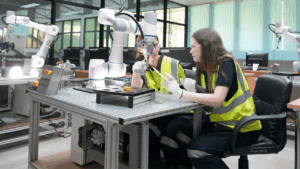In the first two parts of this blog series, we learned that effective communication and knowing how to motivate others are vital to demonstrate environmental leadership.
The third critical skill to advance your environmental leadership is strategic thinking. Learn why building your strategic thinking skills are necessary to be a leader.
Why Strategic Thinking is Critical
Strategic people can see the connections between ideas, plans, and resources.
Strategic thinking is essential to demonstrating environmental leadership. In fact, research shows that it may be the most important factor in leadership.
As a leader, you need to make informed decisions by strategically evaluating the situation, brainstorming potential solutions and analyzing the possibilities and outcomes.
The good news is that to be more strategic, you don’t need a new title or new role. You can practice being deliberate and planned in how you think and act every day.

Are you a strategic thinker?
Ask yourself the following questions:
- Do you take the time to understand the global environment you’re working in?
- Do you consider both the short-term and long-term when planning?
- Do you look for opportunities rather than focus on the problems?
- Do you incorporate multiple perspectives to make a decision?
- Do you take the time to predict the possible outcomes of a decision?
If you’ve said no to any of the above, you may need to brush up on your strategic thinking skills.
4 Ways to Think More Strategically
1. Know your work environment inside-out
We focus mainly on our day-to-day role, rather than the business environment we work in. But you can’t be strategic if you don’t understand the big picture.
You need to know your company, your business, your competitors and the marketplace:
- Take time to learn and fully understand your company’s goals, vision and values. Most importantly, identify how your role contributes to each of these.
- Stay up-to-date on news, laws and regulations that may impact your industry or your business. Learn what’s changing and why, and if you need to take action.
- Research your company’s major competitors and other organizations in the environmental field. What are they doing well? What could be adopted? Where does your company stand and why?
Understanding the complex business environment you work in will help you anticipate challenges and plan ahead.
2. Challenge your perspective
Acquiring strategic thinking skills requires you to consider multiple perspectives. This could include your staff, the client or other stakeholders.
Question everything instead of accepting information at face value.
Uncover biases and challenge current beliefs and mindsets. Just because you’ve always done something that way, doesn’t mean you should continue to.
Engage in “what-if” thinking. For example, “If we do this, what will our clients think? Is there something we have not considered?”
3. Adapt
Strategic thinkers are willing to change directions and pursue new goals when it makes sense to do so.
You’ll need to consider worst-case scenarios, long-term consequences and possibilities.
But you’ll need to leave your ego at the door. Don’t take it personal if your idea may need to shift to changing project conditions.
4. Make a Decision
Sometimes leaders need to take a stand and make a decision. You may not have all the information required to make the best decision, so you’ll need to arrive at a “good enough” position.
You may need to make a decision based on what you know now.
Don’t be a perfectionist. Balance timing, quality and practicality in your decision making.
Leaders also know when they need to re-evaluate a decision, based on new information. Check; Kroger Weekly Ad, ALDI Weekly Ad, ALDI Catalogue, IGA Catalogue, Meijer Weekly Ad, Publix Weekly Ad, Coles Catalogue, Supercheap Auto Catalogue.
Environmental Leaders are Strategic Thinkers
Build your strategic thinking skills by knowing your business environment, challenging your perspective, adapting to the situation, and making a decision.
What are other ways you can improve this skill?






